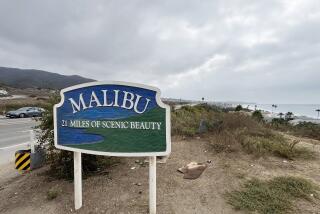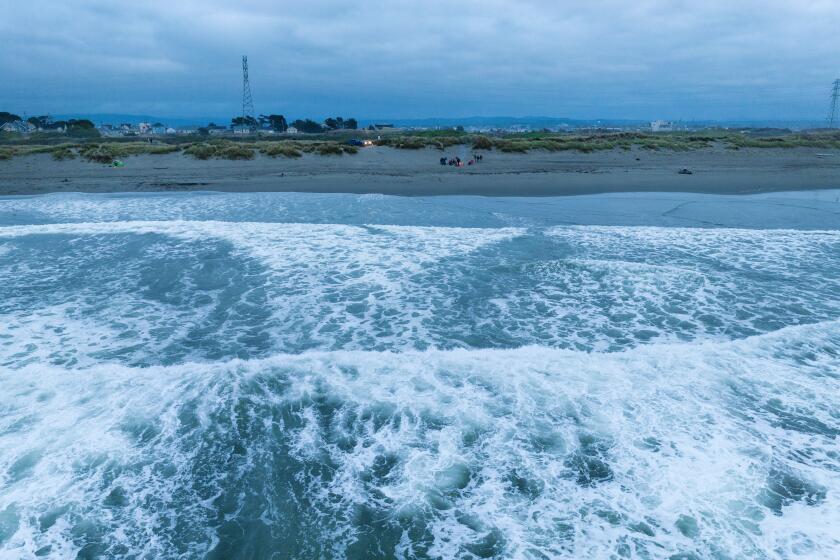Science Is Left a Bit Rattled by the Quake That Didn’t Come
- Share via
Seldom has an earthquake gotten so much attention for not happening.
Earlier this year, an international research team led by 83-year-old UCLA professor Vladimir Keilis-Borok had forecast that a moderate quake would rattle the California desert before Sept. 5 and, for the last week, the state’s earthquake experts had anxiously watched their seismometers to see if he would be correct.
“One doesn’t hope for an earthquake. That sounds awful. But part of me hoped it was true,” said Lucy Jones, who is in charge of the U.S. Geological Survey’s Pasadena office.
“I’ve spent much of my life looking at some aspects of quake prediction, and looking at whether it’s possible,” she said. “I don’t see how his technique is useful as a form of prediction, but if he was right, it would be scientifically important as something to look out for.”
This time he wasn’t right.
For years, seismologists have sought some method for predicting temblors. After Keilis-Borok predicted -- albeit in a general way -- the Paso Robles quake last December and one in Japan a year ago, his method had captured the imagination of many skeptics.
Now it appears to be just one more in a long line of prediction methods that haven’t worked reliably -- to the disappointment of many.
“It’s a little less promising than it looked six months ago,” conceded John Vidale, a UCLA professor of geophysics and interim director of the Institute of Geophysics and Planetary Physics.
Like many other scientists, Vidale was hoping the ground would shake. He even bet another UCLA seismologist, David Jackson, $10 that the latest prediction would come true.
“I paid it off an hour ago,” he said.
Keilis-Borok insisted that his methodology remains sound. He has always said that up to 50% of his predictions would turn out to be false alarms -- and this was simply one of them.
“Famous American saying, ‘That is the way it goes,’ ” Keilis-Borok said in his Russian accent. “We made three predictions. Three predictions, and two were correct and one was wrong.”
The scientist, who in his spare time tries to predict the popular vote in presidential elections, then added: “To quote Churchill, ‘This is not the beginning of the end, it’s the end of the beginning.’ ”
Still, some colleagues said the failure has to be something of a letdown for a scientist who was treated like a rock star at an earthquake convention this summer in Palm Springs.
His speech at the Seismological Society of America drew the biggest audience. Afterward, he was mobbed by journalists and fellow scientists interested in his prediction techniques.
UC Irvine earthquake scientist Lisa Grant said Keilis-Borok displayed courage by going public with his prediction, knowing it could turn out to be incorrect.
“Why did all of us sit there, including me, glued to the screen?” Grant said. “Because whether we agreed with his method or not, there was just a curiosity about someone sticking their neck out and doing this publicly.”
Keilis-Borok, who emigrated from Russia four decades ago, has been working on ways to predict temblors for years -- a quest he has called “the Holy Grail of earthquake science.”
He is not alone: Scientists across the globe -- notably in China and Japan -- have been working on similar projects.
Keilis-Borok, a seismologist and mathematical geophysicist, thought he and his international team of scientists had found the magic bullet last year. The team examined “precursory chains” of small quakes that had occurred in the past to develop predictions about larger quakes that would occur in the future.
The Keilis-Borok team does not predict the date, place or magnitude of a quake. Rather, it uses general times and locations.
For example, the team forecast in June 2003 that a quake of at least 6.4 would hit the California coast somewhere between Fort Bragg and Cambria -- a 310-mile-long area. They said the quake would occur sometime before March 2004.
On Dec. 22, 2003, a 6.5-magnitude temblor struck six miles northeast of San Simeon, on the southern edge of the team’s boundary. The quake killed two people in Paso Robles and caused $250 million damage.
In January, Keilis-Borok predicted an earthquake of at least 6.4 magnitude would occur by Sept. 5 in a 12,000-square-mile area in the Mojave Desert. Unlike his previous predictions, he made this one public.
One reason his early success generated so much excitement is that the scientific community has become so doubtful that quakes can be predicted.
“We’re more pessimistic about quake prediction now than we were 40 years ago,” said Clarence Allen, a professor emeritus of geology and geophysics at Caltech.
So many theories have come and gone without advancing the cause, Vidale added: Does the chemistry of water change just before a quake? Do pets and other animals run away because they can sense one coming?
After years of writing off quake predictions as “hopeless endeavors,” Vidale said it was refreshing to see that scientists were open-minded -- and in some cases even excited -- about Keilis-Borok’s prediction.
“To really know how well this works, it will take 10 trials,” Vidale added.
As for Keilis-Borok, he said his team’s research will continue, but probably with less public scrutiny. He said future predictions will be relayed only to “professionals in the field” and not to the news media.
“Predictions may cause anxiety in the population,” he said.







